Technology's Influence on English Language Education in Australia
VerifiedAdded on 2021/06/15
|25
|4934
|86
Report
AI Summary
This research paper investigates the impact of technology on English Language Learners (ELLs) in Australian secondary education (Years 7-12). The study explores the use of technology to support EAL/D students, focusing on teaching strategies and methods. It examines the challenges faced by ELLs, the role of technology in addressing their needs, and the experiences of instructors in using technology as a teaching tool. The paper reviews literature on technology in classrooms, ELLs, and the use of smart boards and tablets. The research employs a descriptive methodology, utilizing internal secondary data collection to analyze the role of technology in supporting ELLs, the challenges in integrating technology, and strategies to enhance learning. The findings highlight how technology can facilitate language acquisition, improve communication skills, and provide access to the Australian curriculum. Recommendations are made for conceptual approaches to enhance learning strategies, emphasizing the importance of technology in creating an inclusive and supportive learning environment for ELLs in Australia.

Running head: TECHNOLOGY IN AND FOR ENGLISH LANGUAGE
Technology in and for English language
Name of the Student
Name of the University
Author Note
Technology in and for English language
Name of the Student
Name of the University
Author Note
Paraphrase This Document
Need a fresh take? Get an instant paraphrase of this document with our AI Paraphraser
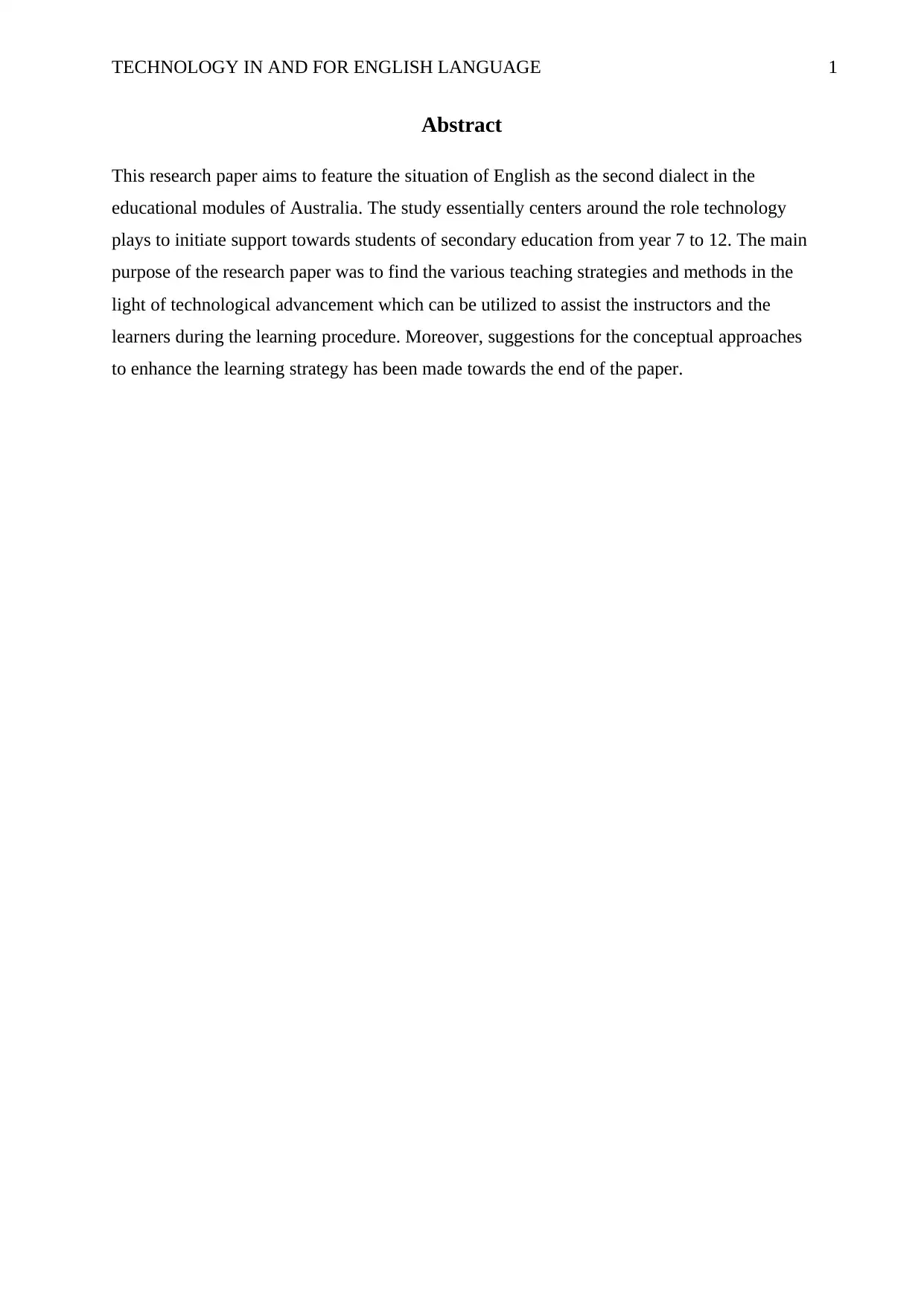
TECHNOLOGY IN AND FOR ENGLISH LANGUAGE 1
Abstract
This research paper aims to feature the situation of English as the second dialect in the
educational modules of Australia. The study essentially centers around the role technology
plays to initiate support towards students of secondary education from year 7 to 12. The main
purpose of the research paper was to find the various teaching strategies and methods in the
light of technological advancement which can be utilized to assist the instructors and the
learners during the learning procedure. Moreover, suggestions for the conceptual approaches
to enhance the learning strategy has been made towards the end of the paper.
Abstract
This research paper aims to feature the situation of English as the second dialect in the
educational modules of Australia. The study essentially centers around the role technology
plays to initiate support towards students of secondary education from year 7 to 12. The main
purpose of the research paper was to find the various teaching strategies and methods in the
light of technological advancement which can be utilized to assist the instructors and the
learners during the learning procedure. Moreover, suggestions for the conceptual approaches
to enhance the learning strategy has been made towards the end of the paper.
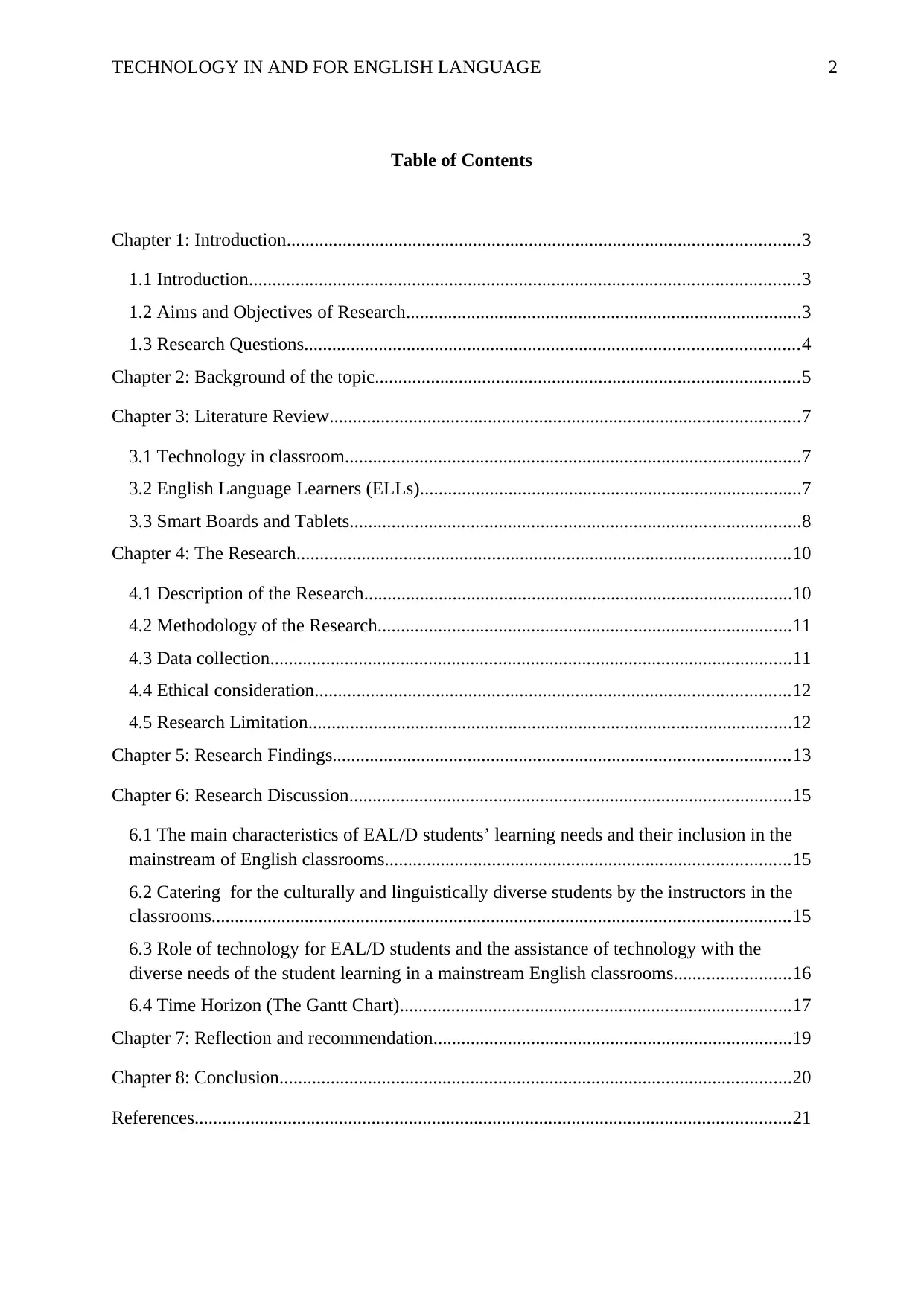
TECHNOLOGY IN AND FOR ENGLISH LANGUAGE 2
Table of Contents
Chapter 1: Introduction..............................................................................................................3
1.1 Introduction......................................................................................................................3
1.2 Aims and Objectives of Research.....................................................................................3
1.3 Research Questions..........................................................................................................4
Chapter 2: Background of the topic...........................................................................................5
Chapter 3: Literature Review.....................................................................................................7
3.1 Technology in classroom..................................................................................................7
3.2 English Language Learners (ELLs)..................................................................................7
3.3 Smart Boards and Tablets.................................................................................................8
Chapter 4: The Research..........................................................................................................10
4.1 Description of the Research............................................................................................10
4.2 Methodology of the Research.........................................................................................11
4.3 Data collection................................................................................................................11
4.4 Ethical consideration......................................................................................................12
4.5 Research Limitation........................................................................................................12
Chapter 5: Research Findings..................................................................................................13
Chapter 6: Research Discussion...............................................................................................15
6.1 The main characteristics of EAL/D students’ learning needs and their inclusion in the
mainstream of English classrooms.......................................................................................15
6.2 Catering for the culturally and linguistically diverse students by the instructors in the
classrooms............................................................................................................................15
6.3 Role of technology for EAL/D students and the assistance of technology with the
diverse needs of the student learning in a mainstream English classrooms.........................16
6.4 Time Horizon (The Gantt Chart)....................................................................................17
Chapter 7: Reflection and recommendation.............................................................................19
Chapter 8: Conclusion..............................................................................................................20
References................................................................................................................................21
Table of Contents
Chapter 1: Introduction..............................................................................................................3
1.1 Introduction......................................................................................................................3
1.2 Aims and Objectives of Research.....................................................................................3
1.3 Research Questions..........................................................................................................4
Chapter 2: Background of the topic...........................................................................................5
Chapter 3: Literature Review.....................................................................................................7
3.1 Technology in classroom..................................................................................................7
3.2 English Language Learners (ELLs)..................................................................................7
3.3 Smart Boards and Tablets.................................................................................................8
Chapter 4: The Research..........................................................................................................10
4.1 Description of the Research............................................................................................10
4.2 Methodology of the Research.........................................................................................11
4.3 Data collection................................................................................................................11
4.4 Ethical consideration......................................................................................................12
4.5 Research Limitation........................................................................................................12
Chapter 5: Research Findings..................................................................................................13
Chapter 6: Research Discussion...............................................................................................15
6.1 The main characteristics of EAL/D students’ learning needs and their inclusion in the
mainstream of English classrooms.......................................................................................15
6.2 Catering for the culturally and linguistically diverse students by the instructors in the
classrooms............................................................................................................................15
6.3 Role of technology for EAL/D students and the assistance of technology with the
diverse needs of the student learning in a mainstream English classrooms.........................16
6.4 Time Horizon (The Gantt Chart)....................................................................................17
Chapter 7: Reflection and recommendation.............................................................................19
Chapter 8: Conclusion..............................................................................................................20
References................................................................................................................................21
⊘ This is a preview!⊘
Do you want full access?
Subscribe today to unlock all pages.

Trusted by 1+ million students worldwide

TECHNOLOGY IN AND FOR ENGLISH LANGUAGE 3
Paraphrase This Document
Need a fresh take? Get an instant paraphrase of this document with our AI Paraphraser

TECHNOLOGY IN AND FOR ENGLISH LANGUAGE 4
Topic: Technology in and for the English language
Chapter 1: Introduction
1.1 Introduction
The quality of research in Australia is one of the reasons why students are attracted to
pursue their career in the country. Australia is known to be one of the best spenders in the
area for innovative work with the noteworthy achievement of embracing new and current
advancements. The growth of the technology has several impacts on the increased
opportunities for the design, innovation and the improvement in learning English among the
students and the learners in Australia (Willett et al., 2017). Researchers concluded that
students in the country need more support in learning the language since their language is
other than English. English Language Learners (ELL) or the general classroom students need
guidance to achieve success in their academic career (Mellati, Zangoei & Khademi, 2015).
One of the major concerns of the parents and the instructors is to facilitate and form an
environment where they can utilize all the resources and modern technologies in an effective
way for the benefit of the learners.
1.2 Aims and Objectives of Research
The aims of this research are as follows:
To examine the role of the technology in the support of the ELLs in the secondary
classroom of the grade 7 to 12 in the current date.
To summarize how technology supports English as the second language in the
mainstream secondary English classrooms in Australia.
To highlight the experience of the instructors in using the technology as a tool for
teaching.
Topic: Technology in and for the English language
Chapter 1: Introduction
1.1 Introduction
The quality of research in Australia is one of the reasons why students are attracted to
pursue their career in the country. Australia is known to be one of the best spenders in the
area for innovative work with the noteworthy achievement of embracing new and current
advancements. The growth of the technology has several impacts on the increased
opportunities for the design, innovation and the improvement in learning English among the
students and the learners in Australia (Willett et al., 2017). Researchers concluded that
students in the country need more support in learning the language since their language is
other than English. English Language Learners (ELL) or the general classroom students need
guidance to achieve success in their academic career (Mellati, Zangoei & Khademi, 2015).
One of the major concerns of the parents and the instructors is to facilitate and form an
environment where they can utilize all the resources and modern technologies in an effective
way for the benefit of the learners.
1.2 Aims and Objectives of Research
The aims of this research are as follows:
To examine the role of the technology in the support of the ELLs in the secondary
classroom of the grade 7 to 12 in the current date.
To summarize how technology supports English as the second language in the
mainstream secondary English classrooms in Australia.
To highlight the experience of the instructors in using the technology as a tool for
teaching.
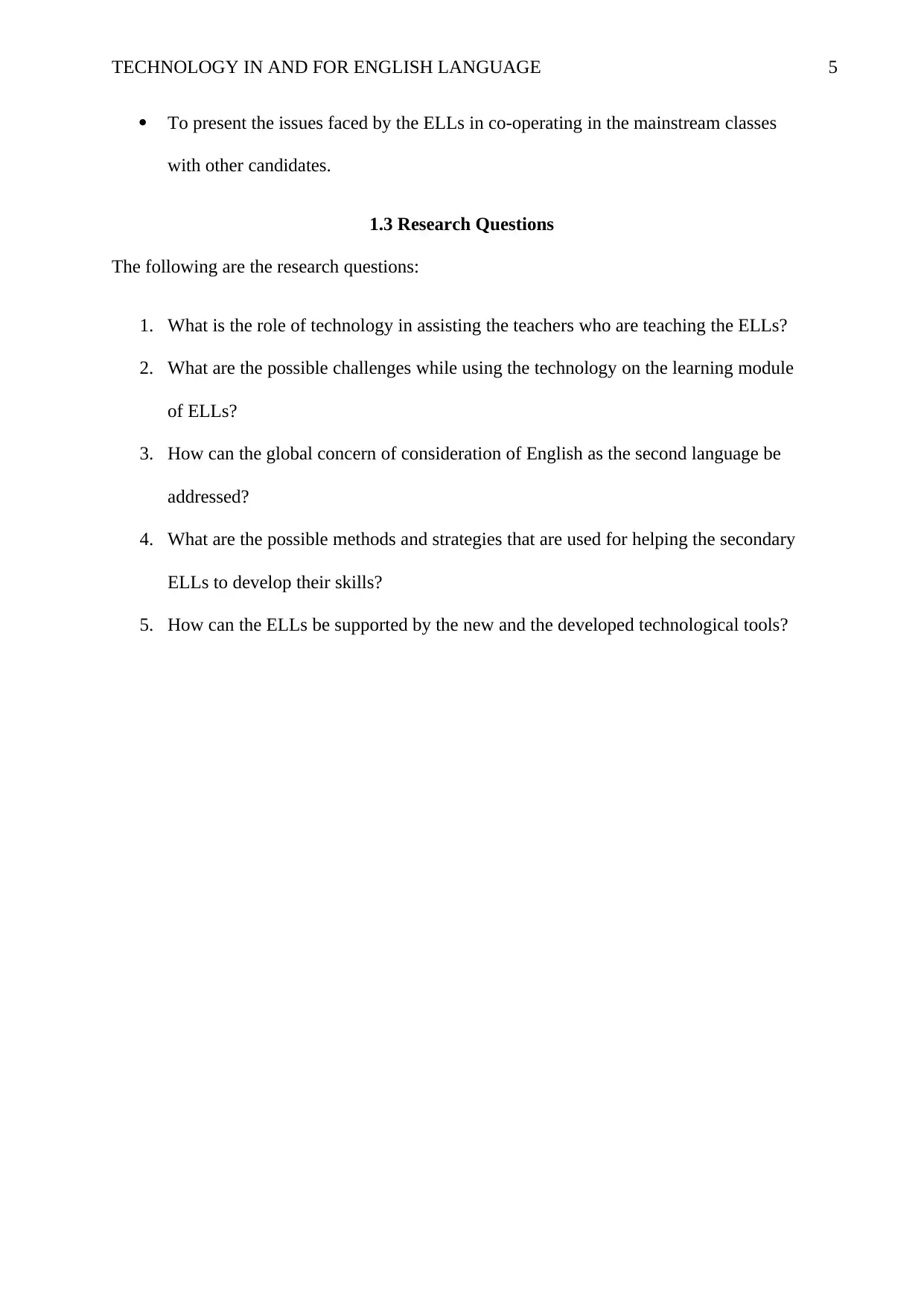
TECHNOLOGY IN AND FOR ENGLISH LANGUAGE 5
To present the issues faced by the ELLs in co-operating in the mainstream classes
with other candidates.
1.3 Research Questions
The following are the research questions:
1. What is the role of technology in assisting the teachers who are teaching the ELLs?
2. What are the possible challenges while using the technology on the learning module
of ELLs?
3. How can the global concern of consideration of English as the second language be
addressed?
4. What are the possible methods and strategies that are used for helping the secondary
ELLs to develop their skills?
5. How can the ELLs be supported by the new and the developed technological tools?
To present the issues faced by the ELLs in co-operating in the mainstream classes
with other candidates.
1.3 Research Questions
The following are the research questions:
1. What is the role of technology in assisting the teachers who are teaching the ELLs?
2. What are the possible challenges while using the technology on the learning module
of ELLs?
3. How can the global concern of consideration of English as the second language be
addressed?
4. What are the possible methods and strategies that are used for helping the secondary
ELLs to develop their skills?
5. How can the ELLs be supported by the new and the developed technological tools?
⊘ This is a preview!⊘
Do you want full access?
Subscribe today to unlock all pages.

Trusted by 1+ million students worldwide
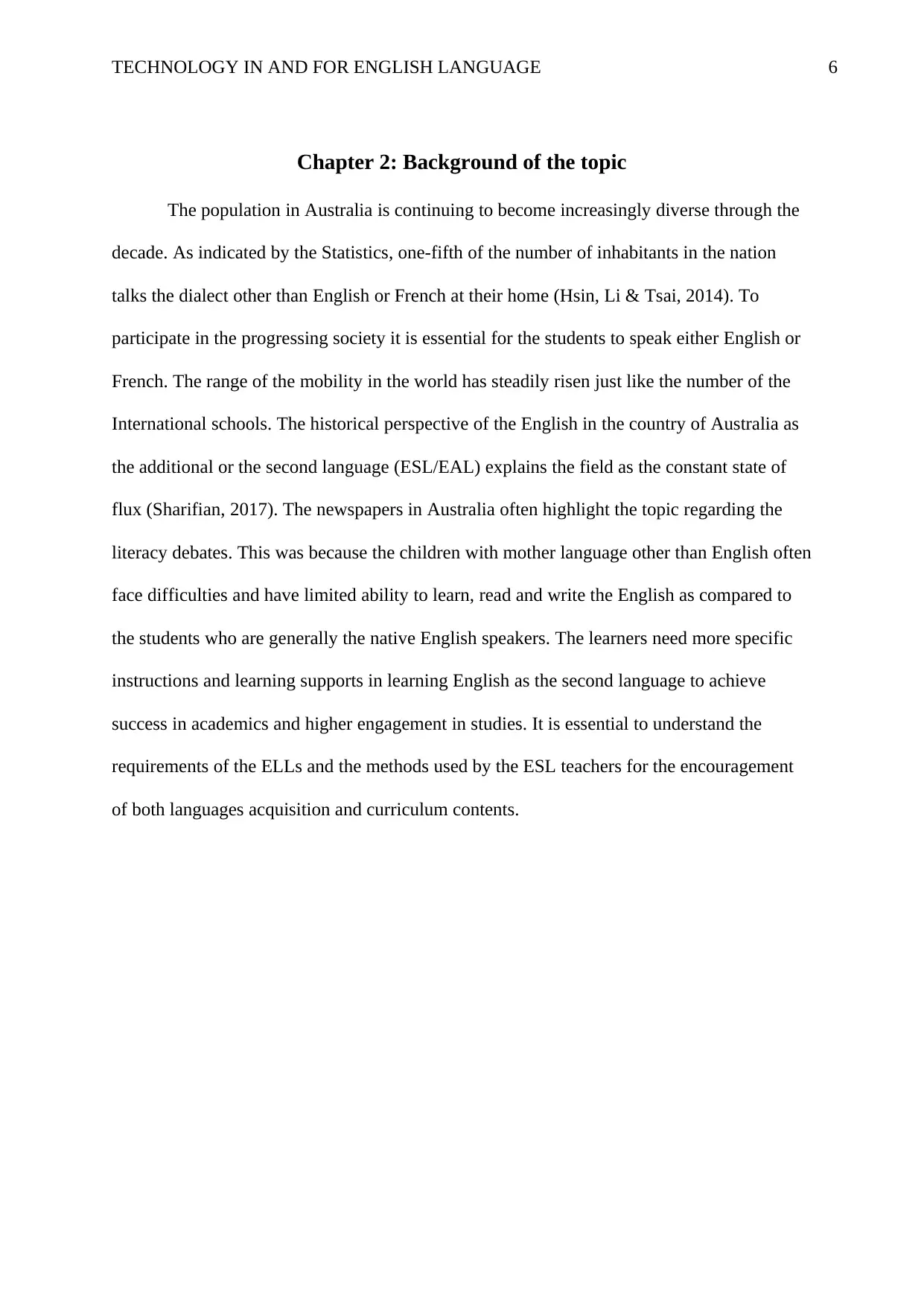
TECHNOLOGY IN AND FOR ENGLISH LANGUAGE 6
Chapter 2: Background of the topic
The population in Australia is continuing to become increasingly diverse through the
decade. As indicated by the Statistics, one-fifth of the number of inhabitants in the nation
talks the dialect other than English or French at their home (Hsin, Li & Tsai, 2014). To
participate in the progressing society it is essential for the students to speak either English or
French. The range of the mobility in the world has steadily risen just like the number of the
International schools. The historical perspective of the English in the country of Australia as
the additional or the second language (ESL/EAL) explains the field as the constant state of
flux (Sharifian, 2017). The newspapers in Australia often highlight the topic regarding the
literacy debates. This was because the children with mother language other than English often
face difficulties and have limited ability to learn, read and write the English as compared to
the students who are generally the native English speakers. The learners need more specific
instructions and learning supports in learning English as the second language to achieve
success in academics and higher engagement in studies. It is essential to understand the
requirements of the ELLs and the methods used by the ESL teachers for the encouragement
of both languages acquisition and curriculum contents.
Chapter 2: Background of the topic
The population in Australia is continuing to become increasingly diverse through the
decade. As indicated by the Statistics, one-fifth of the number of inhabitants in the nation
talks the dialect other than English or French at their home (Hsin, Li & Tsai, 2014). To
participate in the progressing society it is essential for the students to speak either English or
French. The range of the mobility in the world has steadily risen just like the number of the
International schools. The historical perspective of the English in the country of Australia as
the additional or the second language (ESL/EAL) explains the field as the constant state of
flux (Sharifian, 2017). The newspapers in Australia often highlight the topic regarding the
literacy debates. This was because the children with mother language other than English often
face difficulties and have limited ability to learn, read and write the English as compared to
the students who are generally the native English speakers. The learners need more specific
instructions and learning supports in learning English as the second language to achieve
success in academics and higher engagement in studies. It is essential to understand the
requirements of the ELLs and the methods used by the ESL teachers for the encouragement
of both languages acquisition and curriculum contents.
Paraphrase This Document
Need a fresh take? Get an instant paraphrase of this document with our AI Paraphraser
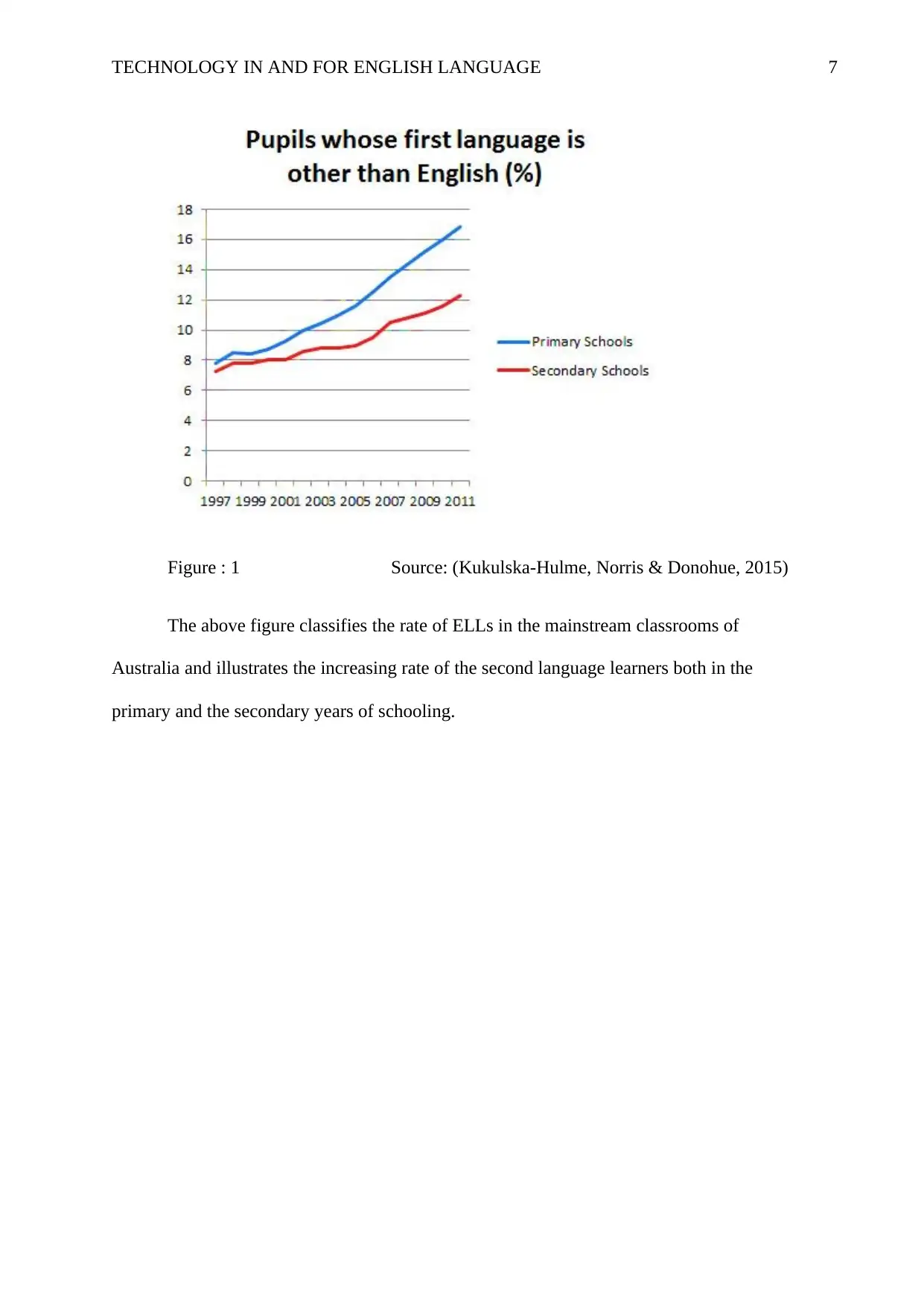
TECHNOLOGY IN AND FOR ENGLISH LANGUAGE 7
Figure : 1 Source: (Kukulska-Hulme, Norris & Donohue, 2015)
The above figure classifies the rate of ELLs in the mainstream classrooms of
Australia and illustrates the increasing rate of the second language learners both in the
primary and the secondary years of schooling.
Figure : 1 Source: (Kukulska-Hulme, Norris & Donohue, 2015)
The above figure classifies the rate of ELLs in the mainstream classrooms of
Australia and illustrates the increasing rate of the second language learners both in the
primary and the secondary years of schooling.
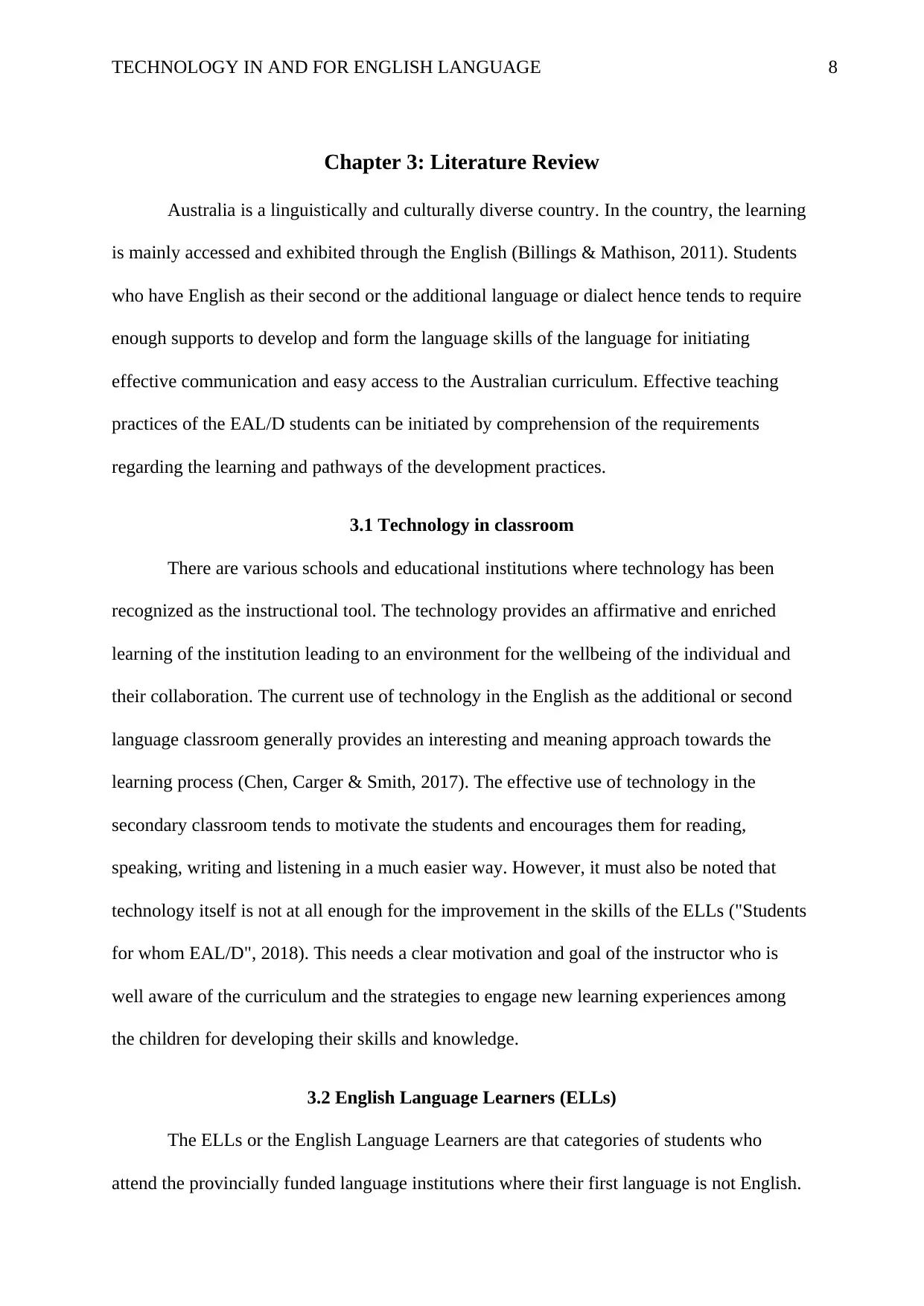
TECHNOLOGY IN AND FOR ENGLISH LANGUAGE 8
Chapter 3: Literature Review
Australia is a linguistically and culturally diverse country. In the country, the learning
is mainly accessed and exhibited through the English (Billings & Mathison, 2011). Students
who have English as their second or the additional language or dialect hence tends to require
enough supports to develop and form the language skills of the language for initiating
effective communication and easy access to the Australian curriculum. Effective teaching
practices of the EAL/D students can be initiated by comprehension of the requirements
regarding the learning and pathways of the development practices.
3.1 Technology in classroom
There are various schools and educational institutions where technology has been
recognized as the instructional tool. The technology provides an affirmative and enriched
learning of the institution leading to an environment for the wellbeing of the individual and
their collaboration. The current use of technology in the English as the additional or second
language classroom generally provides an interesting and meaning approach towards the
learning process (Chen, Carger & Smith, 2017). The effective use of technology in the
secondary classroom tends to motivate the students and encourages them for reading,
speaking, writing and listening in a much easier way. However, it must also be noted that
technology itself is not at all enough for the improvement in the skills of the ELLs ("Students
for whom EAL/D", 2018). This needs a clear motivation and goal of the instructor who is
well aware of the curriculum and the strategies to engage new learning experiences among
the children for developing their skills and knowledge.
3.2 English Language Learners (ELLs)
The ELLs or the English Language Learners are that categories of students who
attend the provincially funded language institutions where their first language is not English.
Chapter 3: Literature Review
Australia is a linguistically and culturally diverse country. In the country, the learning
is mainly accessed and exhibited through the English (Billings & Mathison, 2011). Students
who have English as their second or the additional language or dialect hence tends to require
enough supports to develop and form the language skills of the language for initiating
effective communication and easy access to the Australian curriculum. Effective teaching
practices of the EAL/D students can be initiated by comprehension of the requirements
regarding the learning and pathways of the development practices.
3.1 Technology in classroom
There are various schools and educational institutions where technology has been
recognized as the instructional tool. The technology provides an affirmative and enriched
learning of the institution leading to an environment for the wellbeing of the individual and
their collaboration. The current use of technology in the English as the additional or second
language classroom generally provides an interesting and meaning approach towards the
learning process (Chen, Carger & Smith, 2017). The effective use of technology in the
secondary classroom tends to motivate the students and encourages them for reading,
speaking, writing and listening in a much easier way. However, it must also be noted that
technology itself is not at all enough for the improvement in the skills of the ELLs ("Students
for whom EAL/D", 2018). This needs a clear motivation and goal of the instructor who is
well aware of the curriculum and the strategies to engage new learning experiences among
the children for developing their skills and knowledge.
3.2 English Language Learners (ELLs)
The ELLs or the English Language Learners are that categories of students who
attend the provincially funded language institutions where their first language is not English.
⊘ This is a preview!⊘
Do you want full access?
Subscribe today to unlock all pages.

Trusted by 1+ million students worldwide
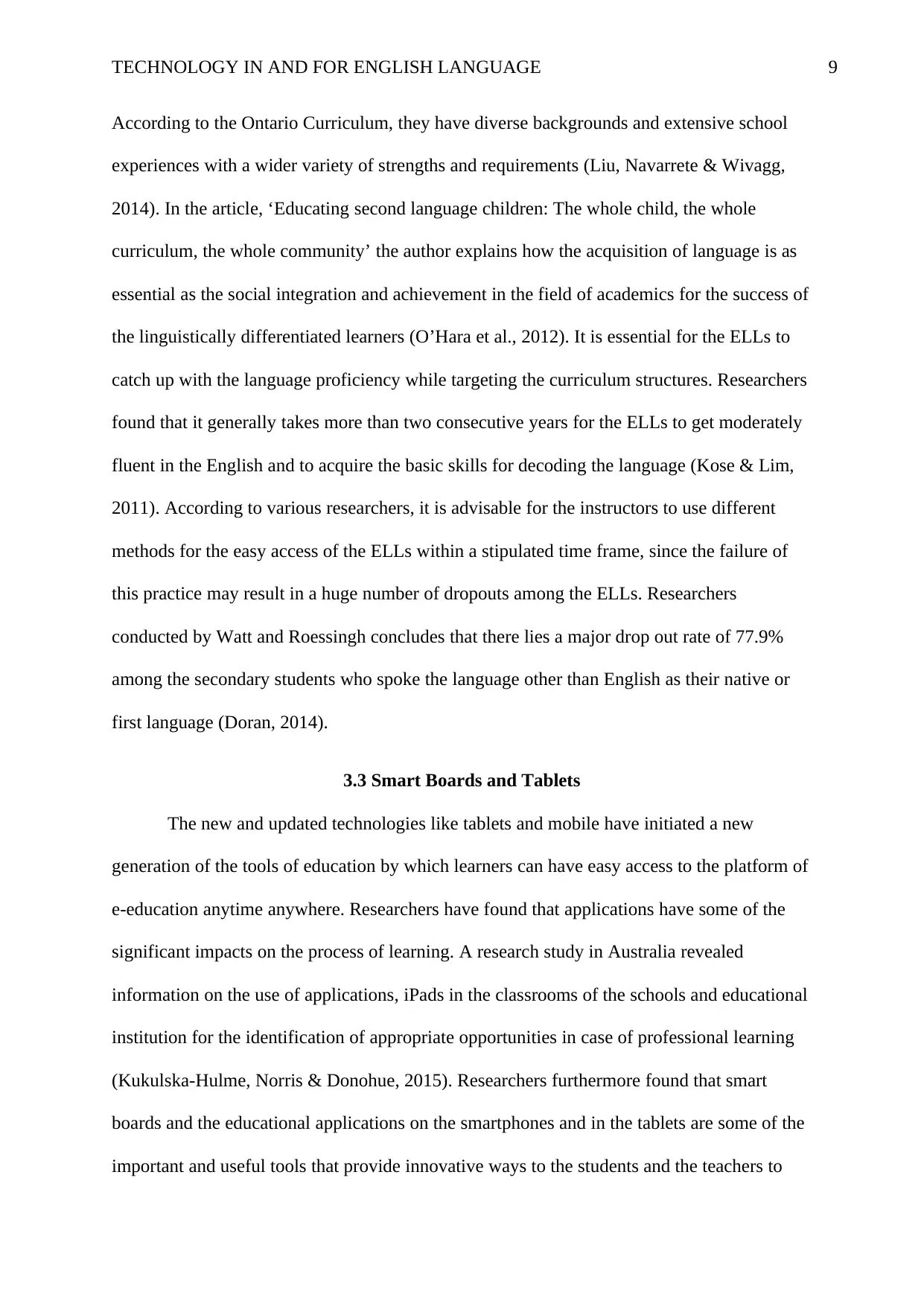
TECHNOLOGY IN AND FOR ENGLISH LANGUAGE 9
According to the Ontario Curriculum, they have diverse backgrounds and extensive school
experiences with a wider variety of strengths and requirements (Liu, Navarrete & Wivagg,
2014). In the article, ‘Educating second language children: The whole child, the whole
curriculum, the whole community’ the author explains how the acquisition of language is as
essential as the social integration and achievement in the field of academics for the success of
the linguistically differentiated learners (O’Hara et al., 2012). It is essential for the ELLs to
catch up with the language proficiency while targeting the curriculum structures. Researchers
found that it generally takes more than two consecutive years for the ELLs to get moderately
fluent in the English and to acquire the basic skills for decoding the language (Kose & Lim,
2011). According to various researchers, it is advisable for the instructors to use different
methods for the easy access of the ELLs within a stipulated time frame, since the failure of
this practice may result in a huge number of dropouts among the ELLs. Researchers
conducted by Watt and Roessingh concludes that there lies a major drop out rate of 77.9%
among the secondary students who spoke the language other than English as their native or
first language (Doran, 2014).
3.3 Smart Boards and Tablets
The new and updated technologies like tablets and mobile have initiated a new
generation of the tools of education by which learners can have easy access to the platform of
e-education anytime anywhere. Researchers have found that applications have some of the
significant impacts on the process of learning. A research study in Australia revealed
information on the use of applications, iPads in the classrooms of the schools and educational
institution for the identification of appropriate opportunities in case of professional learning
(Kukulska-Hulme, Norris & Donohue, 2015). Researchers furthermore found that smart
boards and the educational applications on the smartphones and in the tablets are some of the
important and useful tools that provide innovative ways to the students and the teachers to
According to the Ontario Curriculum, they have diverse backgrounds and extensive school
experiences with a wider variety of strengths and requirements (Liu, Navarrete & Wivagg,
2014). In the article, ‘Educating second language children: The whole child, the whole
curriculum, the whole community’ the author explains how the acquisition of language is as
essential as the social integration and achievement in the field of academics for the success of
the linguistically differentiated learners (O’Hara et al., 2012). It is essential for the ELLs to
catch up with the language proficiency while targeting the curriculum structures. Researchers
found that it generally takes more than two consecutive years for the ELLs to get moderately
fluent in the English and to acquire the basic skills for decoding the language (Kose & Lim,
2011). According to various researchers, it is advisable for the instructors to use different
methods for the easy access of the ELLs within a stipulated time frame, since the failure of
this practice may result in a huge number of dropouts among the ELLs. Researchers
conducted by Watt and Roessingh concludes that there lies a major drop out rate of 77.9%
among the secondary students who spoke the language other than English as their native or
first language (Doran, 2014).
3.3 Smart Boards and Tablets
The new and updated technologies like tablets and mobile have initiated a new
generation of the tools of education by which learners can have easy access to the platform of
e-education anytime anywhere. Researchers have found that applications have some of the
significant impacts on the process of learning. A research study in Australia revealed
information on the use of applications, iPads in the classrooms of the schools and educational
institution for the identification of appropriate opportunities in case of professional learning
(Kukulska-Hulme, Norris & Donohue, 2015). Researchers furthermore found that smart
boards and the educational applications on the smartphones and in the tablets are some of the
important and useful tools that provide innovative ways to the students and the teachers to
Paraphrase This Document
Need a fresh take? Get an instant paraphrase of this document with our AI Paraphraser
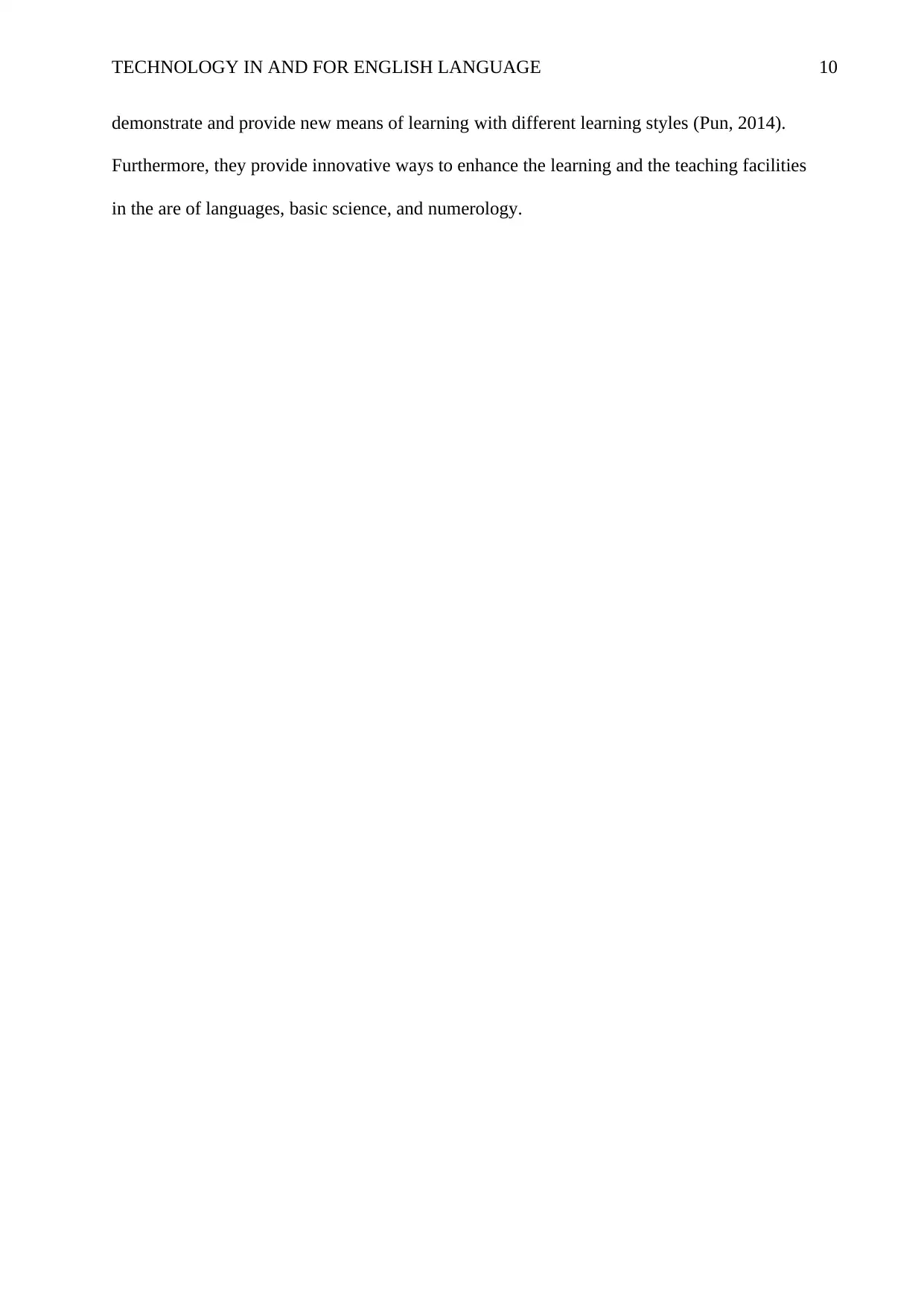
TECHNOLOGY IN AND FOR ENGLISH LANGUAGE 10
demonstrate and provide new means of learning with different learning styles (Pun, 2014).
Furthermore, they provide innovative ways to enhance the learning and the teaching facilities
in the are of languages, basic science, and numerology.
demonstrate and provide new means of learning with different learning styles (Pun, 2014).
Furthermore, they provide innovative ways to enhance the learning and the teaching facilities
in the are of languages, basic science, and numerology.
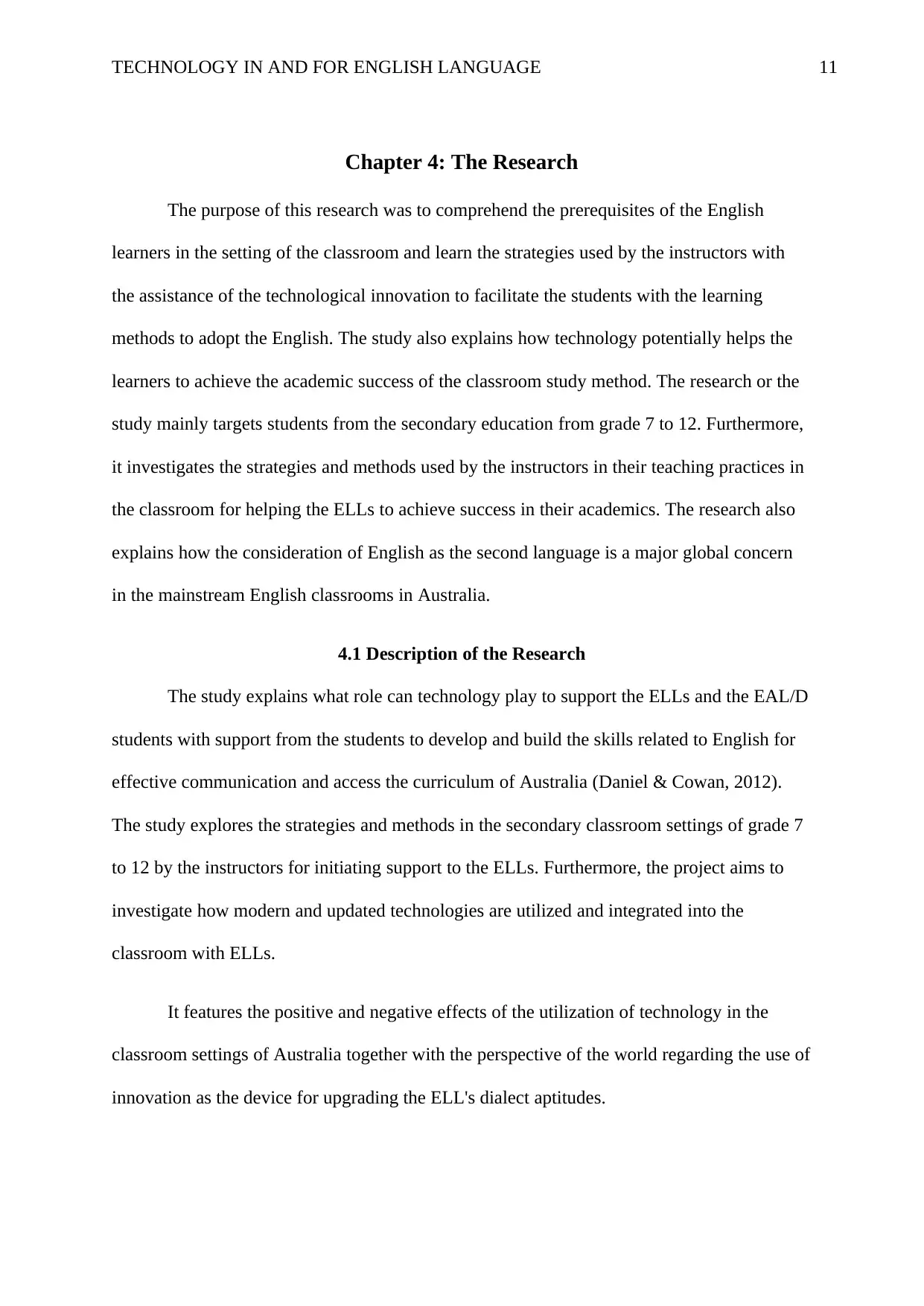
TECHNOLOGY IN AND FOR ENGLISH LANGUAGE 11
Chapter 4: The Research
The purpose of this research was to comprehend the prerequisites of the English
learners in the setting of the classroom and learn the strategies used by the instructors with
the assistance of the technological innovation to facilitate the students with the learning
methods to adopt the English. The study also explains how technology potentially helps the
learners to achieve the academic success of the classroom study method. The research or the
study mainly targets students from the secondary education from grade 7 to 12. Furthermore,
it investigates the strategies and methods used by the instructors in their teaching practices in
the classroom for helping the ELLs to achieve success in their academics. The research also
explains how the consideration of English as the second language is a major global concern
in the mainstream English classrooms in Australia.
4.1 Description of the Research
The study explains what role can technology play to support the ELLs and the EAL/D
students with support from the students to develop and build the skills related to English for
effective communication and access the curriculum of Australia (Daniel & Cowan, 2012).
The study explores the strategies and methods in the secondary classroom settings of grade 7
to 12 by the instructors for initiating support to the ELLs. Furthermore, the project aims to
investigate how modern and updated technologies are utilized and integrated into the
classroom with ELLs.
It features the positive and negative effects of the utilization of technology in the
classroom settings of Australia together with the perspective of the world regarding the use of
innovation as the device for upgrading the ELL's dialect aptitudes.
Chapter 4: The Research
The purpose of this research was to comprehend the prerequisites of the English
learners in the setting of the classroom and learn the strategies used by the instructors with
the assistance of the technological innovation to facilitate the students with the learning
methods to adopt the English. The study also explains how technology potentially helps the
learners to achieve the academic success of the classroom study method. The research or the
study mainly targets students from the secondary education from grade 7 to 12. Furthermore,
it investigates the strategies and methods used by the instructors in their teaching practices in
the classroom for helping the ELLs to achieve success in their academics. The research also
explains how the consideration of English as the second language is a major global concern
in the mainstream English classrooms in Australia.
4.1 Description of the Research
The study explains what role can technology play to support the ELLs and the EAL/D
students with support from the students to develop and build the skills related to English for
effective communication and access the curriculum of Australia (Daniel & Cowan, 2012).
The study explores the strategies and methods in the secondary classroom settings of grade 7
to 12 by the instructors for initiating support to the ELLs. Furthermore, the project aims to
investigate how modern and updated technologies are utilized and integrated into the
classroom with ELLs.
It features the positive and negative effects of the utilization of technology in the
classroom settings of Australia together with the perspective of the world regarding the use of
innovation as the device for upgrading the ELL's dialect aptitudes.
⊘ This is a preview!⊘
Do you want full access?
Subscribe today to unlock all pages.

Trusted by 1+ million students worldwide
1 out of 25
Related Documents
Your All-in-One AI-Powered Toolkit for Academic Success.
+13062052269
info@desklib.com
Available 24*7 on WhatsApp / Email
![[object Object]](/_next/static/media/star-bottom.7253800d.svg)
Unlock your academic potential
Copyright © 2020–2025 A2Z Services. All Rights Reserved. Developed and managed by ZUCOL.





